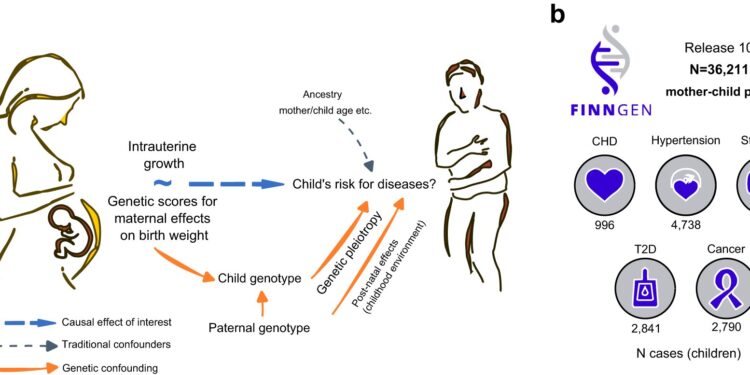Illustration of the Mendelian randomization framework applied to mother-infant pairs with a summary of the FinnGen dataset. Credit: Communication biology (2024). DOI: 10.1038/s42003-024-05872-9
A unique Finnish study investigated the link between growing conditions in the womb and cardiovascular disease in adulthood. The results highlight the importance of genetic factors shared between mother and child.
The relationship between birth weight and adult disease has been widely studied. Most studies show that people born small are at increased risk of developing hypertension and heart disease as adults.
The biological cause of this phenomenon has been debated for decades, but there is no definitive research evidence. A popular theory is that inadequate nutritional intake during pregnancy affects the metabolism of the developing fetus, predisposing it to cardiovascular disease during periods of overeating.
Recent findings from a team led by Academy researcher Taru Tukiainen suggest that the link between birth weight and disease is instead due in part to risk genes shared by mothers and their children. The results are published in the journal Communication biology.
Researchers have found that maternal genetic factors that influence the growth of the developing fetus have an effect independent of birth weight on the child’s later risk of heart disease. However, it appears that these genes only play a role in disease risk when they are passed on to the child.
“Certain maternal genes influence the conditions in which the child grows in the womb and, therefore, its birth weight. The child in turn inherits a copy of these genes from the mother,” explains Jaakko Leinonen , postdoctoral researcher at the Institute of Molecular Biology. Medicine Finland (FIMM) at the University of Helsinki.
“When we studied the impact of these birth weight genes on children’s morbidity later in life, we found that small changes in the baby’s growth before birth, due to to the mother, have a major impact on the child’s risk of developing the disease. Instead, it appears that a child’s genes play a much larger role in determining their future health risks .
Using genetic data from mothers and children
The new research results were obtained by examining the genetic data of mothers and their adult children. The findings are based on more than 36,000 such mother-child pairs, all included in the large Finnish genomic study FinnGen.
According to the research team, previous genetic studies produced partly different results because they failed to distinguish the genetic effects of mother and child.
“Our research method, which uses genetic data from mothers and their children simultaneously, has proven to be a very effective way to find out how maternal health and the condition of the baby in the womb can affect the health of the “child.”, says Dr. Taru Tukiainen, who led the study.
The study in question is the largest study to date on the subject. More research is needed to discover how being born significantly underweight or other significant changes in birth weight affect the risk of disease in adulthood.
“We can be proud that we were able to produce a globally unique research dataset like FinnGen here in Finland, which allows us to find solutions to previously difficult research questions,” says Taru Tukiainen.
More information:
Jaakko T. Leinonen et al, Unraveling the link between maternal influences on birth weight and disease risk in 36,211 genotyped mother-child pairs, Communication biology (2024). DOI: 10.1038/s42003-024-05872-9
Provided by the University of Helsinki
Quote: A genetic study clarifies the link between birth weight and adult morbidity (February 14, 2024) retrieved February 14, 2024 from
This document is subject to copyright. Apart from fair use for private study or research purposes, no part may be reproduced without written permission. The content is provided for information only.



